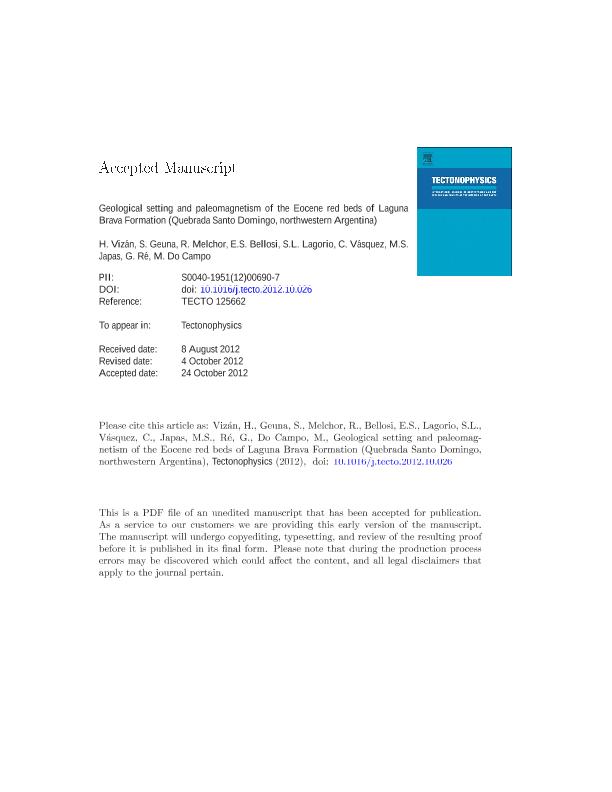Artículo
Geological setting and paleomagnetism of the Eocene red beds of Laguna Brava Formation (Quebrada Santo Domingo, northwestern Argentina)
Vizan, Haroldo ; Geuna, Silvana Evangelina
; Geuna, Silvana Evangelina ; Melchor, Ricardo Nestor
; Melchor, Ricardo Nestor ; Bellosi, Eduardo Sergio
; Bellosi, Eduardo Sergio ; Lagorio, Silvia Leonor; Vasquez, Carlos Alberto
; Lagorio, Silvia Leonor; Vasquez, Carlos Alberto ; Japas, Maria Silvia
; Japas, Maria Silvia ; Re, Guillermo Hector; Do Campo, Margarita Diana
; Re, Guillermo Hector; Do Campo, Margarita Diana
 ; Geuna, Silvana Evangelina
; Geuna, Silvana Evangelina ; Melchor, Ricardo Nestor
; Melchor, Ricardo Nestor ; Bellosi, Eduardo Sergio
; Bellosi, Eduardo Sergio ; Lagorio, Silvia Leonor; Vasquez, Carlos Alberto
; Lagorio, Silvia Leonor; Vasquez, Carlos Alberto ; Japas, Maria Silvia
; Japas, Maria Silvia ; Re, Guillermo Hector; Do Campo, Margarita Diana
; Re, Guillermo Hector; Do Campo, Margarita Diana
Fecha de publicación:
01/2013
Editorial:
Elsevier Science
Revista:
Tectonophysics
ISSN:
0040-1951
Idioma:
Inglés
Tipo de recurso:
Artículo publicado
Clasificación temática:
Resumen
The red bed succession cropping out in the Quebrada Santo Domingo in northwestern Argentina had been for long considered as Upper Triassic-Lower Jurassic in age based on weak radiometric and paleontological evidence. Preliminary paleomagnetic data confirmed the age and opened questions about the nature of fossil footprints with avian features discovered in the section. Recently the stratigraphic scheme was reviewed with the identification of previously unrecognized discontinuities, and a radiometric dating obtained in a tuff, indicated an Eocene age for the Laguna Brava Formation and the fossil bird footprints, much younger than the previously assigned. We present a detailed paleomagnetic study interpreted within a regional tectonic and stratigraphic framework, looking for an explanation for the misinterpretation of the preliminary paleomagnetic data.The characteristic remanent magnetizations pass a tilt test and a reversal test. The main magnetic carrier is interpreted to be low Ti titanomagnetites and to a lesser extent hematite. The characteristic remanent magnetization would be essentially detrital. The obtained paleomagnetic pole (PP) for the Laguna Brava Formation has the following geographic coordinates and statistical parameters: N=29, Lon.=184.5° E, Lat.=75.0° S, A95=5.6° and K=23.7. When this PP is compared with another one with similar age obtained in an undeformed area, a declination anomaly is recognized. This anomaly can be interpreted as Laguna Brava Formation belonging to a structural block that rotated about 16° clockwise along a vertical axis after about 34Ma. This block rotation is consistent with the regional tectonic framework, and would have caused the fortuitous coincidence of the PP with Early Jurassic poles. According to the interpreted magnetostratigraphic correlation, the Laguna Brava Formation would have been deposited during the Late Eocene with a mean sedimentation rate of about 1.4cm per thousand years, probably in relation to the onset of the Andean deformation.
Archivos asociados
Licencia
Identificadores
Colecciones
Articulos(IGEBA)
Articulos de INSTITUTO DE GEOCIENCIAS BASICAS, APLICADAS Y AMBIENTALES DE BS. AS
Articulos de INSTITUTO DE GEOCIENCIAS BASICAS, APLICADAS Y AMBIENTALES DE BS. AS
Articulos(INCITAP)
Articulos de INST.D/CS D/L/TIERRA Y AMBIENTALES D/L/PAMPA
Articulos de INST.D/CS D/L/TIERRA Y AMBIENTALES D/L/PAMPA
Articulos(INGEIS)
Articulos de INST.DE GEOCRONOLOGIA Y GEOLOGIA ISOTOPICA (I)
Articulos de INST.DE GEOCRONOLOGIA Y GEOLOGIA ISOTOPICA (I)
Articulos(MACNBR)
Articulos de MUSEO ARG.DE CS.NAT "BERNARDINO RIVADAVIA"
Articulos de MUSEO ARG.DE CS.NAT "BERNARDINO RIVADAVIA"
Citación
Vizan, Haroldo; Geuna, Silvana Evangelina; Melchor, Ricardo Nestor; Bellosi, Eduardo Sergio; Lagorio, Silvia Leonor; et al.; Geological setting and paleomagnetism of the Eocene red beds of Laguna Brava Formation (Quebrada Santo Domingo, northwestern Argentina); Elsevier Science; Tectonophysics; 583; 1-2013; 105-123
Compartir
Altmétricas



